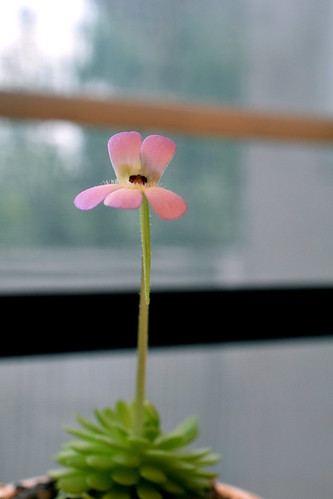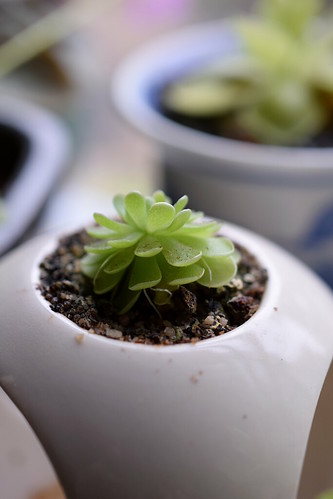Looking for a funky and uncommon plant to add to your collection? Or maybe you’re in need of a solution for those pesky gnats and other flying insects that seem to be an inherent part of growing houseplants? Have I got the plant for you.
Pinguicula esseriana, a Mexican butterwort, is a small carnivorous plant that uses its sticky leaves to catch bugs small bugs. The perfect tiny addition to any (carnivorous) plant collection. And useful too!
Keep reading for everything you need to know about growing Pinguicula esseriana in your own home.
| Difficulty level | Medium |
| Lighting | Full sun |
| Water | Keep lightly moist |
| Soil type | Nutrient free |
Pinguicula esseriana light & temperature
Light
Pinguicula esseriana is native to Mexico, where it’s used to receiving plenty of light. In your home it will appreciate full sun during the morning or evenings; just make sure it doesn’t burn up in intense afternoon sun during summer.
If you can’t provide enough light you’ll have to consider using some artificial lighting to grow your Ping, as it won’t do too well in darker environments.
Temperature
Although this is a tropical plant that is used to dealing with high temperatures and humidity during summer it won’t mind lows too much either. It handles wintertime chill and drought by going dormant, shedding its carnivorous leaves and replacing them with succulent foliage.
So yes: this plant is both a carnivore and a succulent!

Pinguicula esseriana soil & planting
Soil
The natural habitat of Pinguicula esseriana can be quite inhospitable. Many Pinguiculas grow in places that most other plants won’t, like attached to rocks or on steep hillsides. Obviously, these environments don’t exactly offer nutrient-rich soil, which is why the species has evolved to obtain what it needs by catching it itself.
Because Pinguicula roots haven’t evolved to absorb nutrients, your Pinguicula esseriana won’t do well in regular potting soil at all. In fact, any carnivorous plant placed in a nutrient-rich soil type will unfortunately live a rather short life.
Instead, you should go for a soil type that’s free of nutrients. The material should also be well-draining and relatively alkaline.
Planting
Although all carnivore enthusiasts have their own favorite soil recipe, most mixtures contain a blend of the following: perlite, peat, sand, pumice and some added lime for alkalinity. A standard carnivorous plant mix with a little extra sand and lime would work well.
Your Pinguicula esseriana’s planter should have drainage holes at the bottom to avoid fungus or root rot due to overwatering. Cheap plastic nursery pots work fine. Try going for square planters if you like to grow your carnivorous plants in trays (often done for larger collections to allow watering from below).
Did you know? Many carnivorous plant enthusiasts just opt to attach their Pinguiculas to some lava rock, in order to imitate their natural growth habits.

Watering Pinguicula esseriana
- How often and how much you should be watering your Pinguicula esseriana depends mostly on the season.
- As mentioned earlier the area this carnivore naturally occurs in has warm and humid summers. During this time, the medium it grows in is almost always at least lightly moist. You can imitate this in your home by watering your Pinguicula esseriana frequently or even placing the pot in a tray that always contains a layer water. This way, the plant can hydrate through the drainage holes on the bottom.
- When winter rolls around and things start to cool down, you’ll notice Pinguicula esseriana growing different leaves than before. It’s preparing for dormancy by getting its succulent foliage ready.
- As soon as this smaller and non-sticky foliage pops up you can start to reduce waterings. The plant will still need a drink now and then, but you can let the soil dry out fully between waterings.
- Unlike many other carnivorous plants which can only be watered using distilled/demineralized water, Pinguicula can handle water hardness relatively well. I still prefer using demineralized water, though, as that way I won’t have to worry about minerals building up in the soil.

Pinguicula esseriana fertilizer
Because Pinguiculas have evolved to catch their own ‘fertilizer’, they won’t respond well to regular houseplant food at all. In fact, using most fertilizers will quickly kill your Pinguicula esseriana. Using any at all is something best left to expert carnivorous plant growers.
Carnivorous plants don’t have to catch as many bugs as many plant growers think. A Pinguicula esseriana surrounded by other plants in a normal home environment or outside will usually have no problems catching enough gnats and other little creatures to thrive.
If you really feel like the plant is in need of some extra nutrients you can try placing a dried bloodworm or two on the sticky leaves every month or so during the summer growing months. No idea where you can find these? They’re actually usually sold as fish foods.
Propagating Pinguicula esseriana
Pinguicula is probably the easiest carnivorous plant genus to propagate and Pinguicula esseriana is no exception. You can propagate this plant like you would many succulents: by using leaf pullings. This method works year-round, it doesn’t matter whether the Ping is in its succulent or carnivorous phase.
To propagate your Pinguicula esseriana with leaf pullings, all you have to do is gently remove a few leaves. They should come off in their entirety, so be careful not to rip them!
Once you’ve acquired your leaves you can start them in moist ziplock bags or just place them directly on an appropriate soil mix. The former probably works better if you want to make sure you’re getting as many baby Pings as possible, but I like to ‘set and forget’ and simply place leaves on top of the soil in the mother plant’s pot.
The Pinguicula esseriana babies above were produced by leaves that came off the mother plant during repotting (they fall off easily and I always end up with a few casualties when moving a Ping). The soil consists of a mix of the peat that the mother plant came shipped in and quite a bit of added perlite.
Buying Pinguicula esseriana
Pinguicula esseriana isn’t exactly the most common houseplant out there, and not even the most common Pinguicula. You probably won’t find it at your local garden center or plant store, but luckily there are plenty of online sellers that might be able to help you out.
You can try online carnivorous plant stores or one of the various Facebook groups or forums. Some hobbyists are willing to ship you a plant or some cuttings.
Is Pinguicula esseriana toxic to cats and dogs?
I couldn’t find anything specifically pertaining to Pinguicula esseriana toxicity, or even Pinguicula toxicity in general. Apparently Pinguicula leaves are traditionally used to curdle milk in some Scandinavian countries so based on that I’d guess they can’t be too dangerous.
Ingestion of any plant by your pet will most likely cause an upset tummy, though, so you might want to keep your Ping out of its reach regardless.
Cover photo: Esseriana in Bloom by incidencematrix







